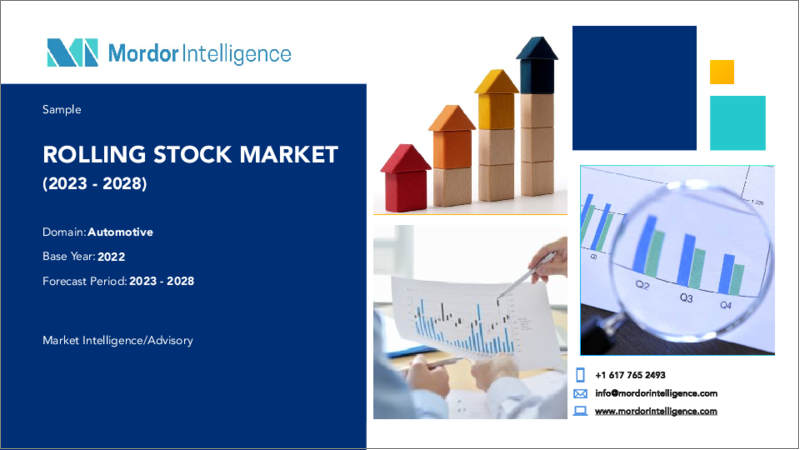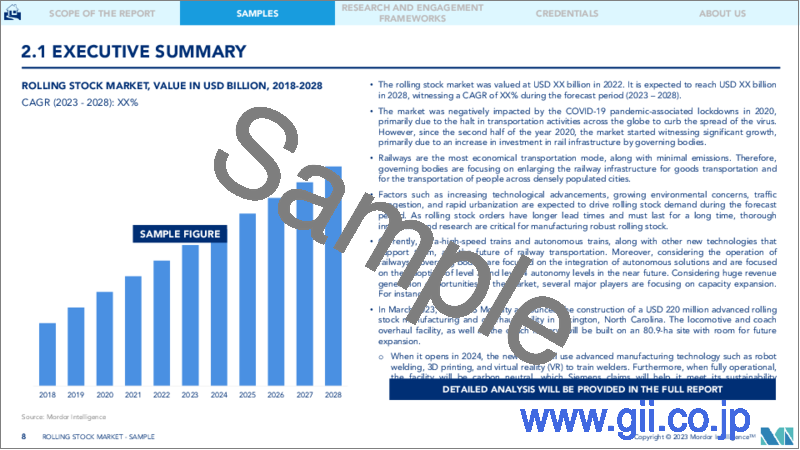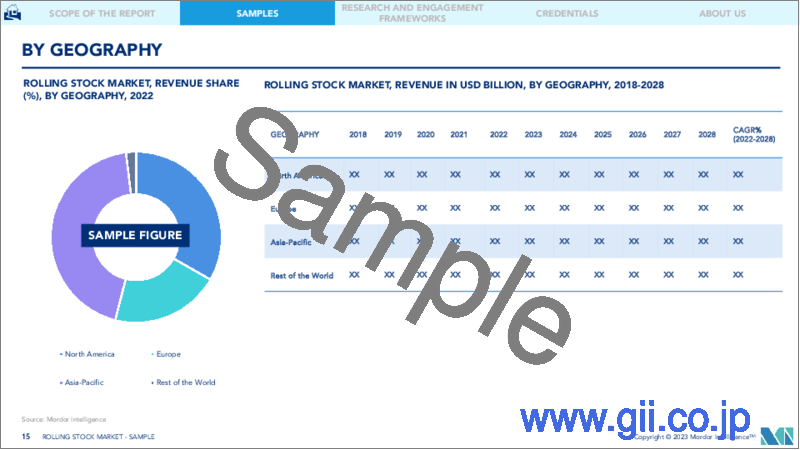|
|
市場調査レポート
商品コード
1198249
鉄道車両市場- 成長、動向、予測(2023年~2028年)Rolling Stock Market - Growth, Trends, and Forecasts (2023 - 2028) |
||||||
|
● お客様のご希望に応じて、既存データの加工や未掲載情報(例:国別セグメント)の追加などの対応が可能です。 詳細はお問い合わせください。 |
|||||||
| 鉄道車両市場- 成長、動向、予測(2023年~2028年) |
|
出版日: 2023年01月23日
発行: Mordor Intelligence
ページ情報: 英文 70 Pages
納期: 2~3営業日
|
- 全表示
- 概要
- 目次
鉄道車両市場は2021年に525億米ドルとなり、予測期間(2023年~2028年)にCAGR4.2%超で成長することで、2027年には672億米ドルに達すると予測されています。
市場は、2020年のCOVID-19によってマイナスの影響を受けました。このパンデミックにより、旅行や観光が中止されました。Alstom(フランス)やBombardier(米国)などの主要鉄道車両メーカーは、サプライチェーンのボトルネック、需要の減少、およびスペイン、米国、イタリア、ドイツ、フランスでの従業員の安全を守るために、COVID流行時の生産停止を表明しています。さらに、研究開発への予算配分が大幅に減少し、革新的な鉄道開発の進展に支障をきたしました。鉄道車両の需要は、政府予算や鉄道事業者の要求とほぼ関連しています。
中期的には、技術の進歩、環境への関心の高まり、交通渋滞、急速な都市化などの要因が、予測期間中の鉄道車両需要を促進すると予測されます。さらに、鉄道車両の受注はリードタイムが長くなり、長期間の使用が求められるため、堅牢な鉄道車両の製造には徹底した技術革新と研究が欠かせません。この市場では、最も安全で安価な交通手段をより快適なものにするために、各国政府の積極的な参入が観察されています。
現在、鉄道輸送の未来を担うのは、超高速列車と自律走行列車であり、それを支える他の新しい技術も相まって、鉄道輸送の未来が見えてきています。例えば、レベル3の欧州鉄道交通管理システム(ECTS)では、軌道側の設備は存在しないことになります。整合性と列車の位置は、トラックサイドの機器(車軸カウンター、信号、軌道回路)に依存せず、代わりに無線ブロックセンター(RBC)と列車によって制御されることになります。
欧州連合(EU)は、約218,000kmの鉄道網を有し、世界で最も多くの電化鉄道を保有しています。EU委員会は、鉄道網を利用者にとってより便利なものにするため、いくつかの法律を制定し、民間企業を誘致して現在の鉄道網を拡大することを義務付けています。例えば、EU委員会は、2030年までに300km以上移動する貨物の30%を他の輸送手段(鉄道や水路)に移行させるという目標を掲げています。
鉄道車両市場の動向
政府の貢献が市場成長を後押し
航空輸送や道路輸送、都市部での交通渋滞など、環境に対する懸念が高まる中、鉄道輸送は環境にやさしく、安価な代替手段となっています。鉄道網の主要国のほとんどでは、鉄道車両の管理は民間企業の管理下に置かれています。しかし、同時に政府もその運営をある程度管理しています。
例えば、世界第4位の鉄道網を持つインドでは、国営の鉄道網があり、2022-23年度のインド鉄道の予算配分は186億米ドルで、前年度比27.5%増となっています。また、政府は近代的な列車を提案する予定であり、すでに一部の路線の列車を民営化しました。同様に、2021年の英国政府は、2021年秋の予算で鉄道網に約632億3000万米ドルを投資する計画を立てていました。
アジア太平洋地域が主要シェアを占めると予想される
鉄道は、日本、インド、中国といったアジアの主要経済圏の乗客の間で好んで利用されている交通手段です。鉄道は、日本、インド、中国といったアジアの主要国で利用されており、年間輸送人員もこの3カ国が圧倒的に多く、鉄道車両市場の主要メーカーもこの地域に本社を構えています。さらに、地方自治体は既存の鉄道網の整備にますます多くの資金を投入しています。例えば、以下の通りです。
- 2021年、中国は固定鉄道資産に1178億6000万米ドルを投資し、2022年の計画では3300kmの新規鉄道路線に投資し、そのうち約1400kmの鉄道路線が高速鉄道、1900kmの鉄道路線が通常速度鉄道の線路となっています。
- インド鉄道は、鉄道車両の製造部門と工場を統合し、新たな公共部門であるインド鉄道車両会社(Indian Railway Rolling Stock Company)を設立する予定です。このPSUは、中国のCRRCグループのような構造になる予定です。さらに、インド鉄道は、鉄道資産の軸受と車輪の故障を検出できる音響軸受検出器(ABD)またはレール軸受音響モニター(RailBAM)からなる新しいOMRSシステムを含めることによって、既存の鉄道網の近代化も進めています。
このような投資は、予測期間中、市場の主要な促進要因であり続けると予想されます。
鉄道車両市場の競合他社分析
鉄道車両市場は統合されており、主なプレーヤーとしてはCRRC、Alstom SA、Siemens AG、Wabtec Corporation、Hyundai Rotemなどが挙げられます。各社は、他の市場参入企業の買収、他の市場参入企業との戦略的提携、新型・高機能鉄道車両の投入などにより、その存在感を高めています。例えば、以下のようなものです。
- 2020年5月、中国鉄道車両公司(CRRC)の子会社であるCRRC Zhuzhou Locomotiveは、欧州の機関車メーカーであるVossloh Group-を買収しました。これにより、CRRCは欧州の鉄道市場で事業を拡大することができます。
- 2020年2月、アルストムは、ボンバルディア・トランスポーテーションの買収に関するMoUをボンバルディア社およびケベック州貯蓄・配置公社(CDPQ)と締結したことを発表しました。ボンバルディア・トランスポーテーションの全株式の取得価格は約60億ユーロ(約6,000億円)。
- スタドラーは2020年1月、ハンガリーの国営旅客事業者MAV-STARTから電気式多連装列車KISS21両を3億4900万米ドルで、米国の交通機関DART(Dallas Area Rapid Transit)から保守契約を1億1200万米ドルで受注しました。
その他の特典
- エクセル形式の市場予測(ME)シート
- アナリストによる3ヶ月間のサポート
目次
第1章 イントロダクション
- 調査の前提条件
- 調査範囲
第2章 調査手法
第3章 エグゼクティブサマリー
第4章 市場力学
- 市場促進要因
- 市場抑制要因
- ポーターのファイブフォース分析
- 新規参入業者の脅威
- 買い手/消費者の交渉力
- 供給企業の交渉力
- 代替品の脅威
- 競争企業間の敵対関係
第5章 市場セグメンテーション
- タイプ別
- ロコモティブス
- 地下鉄
- 客車
- その他のタイプ
- 推進方式別
- ディーゼル
- 電気式
- 電気式ディーゼル
- 地域別で見る
- 北米
- 米国
- カナダ
- その他北米地域
- 欧州
- ドイツ
- 英国
- フランス
- イタリア
- スペイン
- その他の欧州地域
- アジア太平洋地域
- インド
- 中国
- 日本
- 韓国
- その他アジア太平洋地域
- 世界のその他の地域
- ブラジル
- アラブ首長国連邦
- その他の国
- 北米
第6章 競合情勢
- ベンダーの市場シェア
- 企業プロファイル
- China Railway Construction Corporation Limited(CRCC)
- Alstom SA
- Siemens AG
- Wabtec Corporation
- Kawasaki Heavy Industries Ltd
- CJSC Transmashholding
- Stadler Rail
- DescriptionConstrucciones y Auxiliar de Ferrocarriles SA
- Hyundai Rotem
- Mitsubishi Heavy Industries Ltd
第7章 市場機会と今後の動向
The rolling stock market was valued at USD 52.5 billion in 2021, and it is expected to reach USD 67.2 billion by 2027 by registering a CAGR of over 4.2% during the forecast period (2023 - 2028).
The market was negatively impacted by COVID-19 in 2020. Travel and tourism were halted owing to the pandemic. Main rolling stock manufacturers such as Alstom (France) and Bombardier (US) stated the suspension of production owing to the supply chain bottlenecks, fall in demand, and to safeguard the safety of their employees in Spain, United States, Italy, Germany, and France, during the COVID pandemic. Furthermore, budget allotments for R&D were considerably impacted, which hampered the advancement of innovative rail development. The demand for rolling stock is mostly related to government budgets coupled with the requirement from rail operators.
Over the medium term, factors such as increasing technological advancements, growing environmental concerns, traffic congestion, and rapid urbanization are projected to drive the demand for rolling stocks during the forecast period. Furthermore, thorough innovation and research are vital to manufacturing rolling stock that is robust as the rolling stock orders have lengthened lead times and must last for a long time. This market is observing active participation from governments to make the safest and cheapest means of transportation more than comfortable.
Currently, ultra-high-speed trains and autonomous trains are the future of railway transportation, coupled with other new technologies that support it. For instance, in the Level 3 European Rail Traffic Management System (ECTS), trackside equipment will not exist. The integrity and train location will not rely on trackside equipment (axle counters, signals, track circuits); instead will be controlled by the Radio Block Centre (RBC) and train.
The European Union (EU) has the largest electrified rail length in the world, with around 218,000 km of the active rail network. EU commission is obligated to make its rail network more than convenient for passengers by establishing several laws, coupled with enticing private industry players to expand the current network. For instance, the EU commission has set a target of moving 30% of the freight traveled by more than 300 km for other modes of transport (rail or water) by 2030.
Rolling Stock Market Trends
Government Contribution is Promoting to the Market Growth
Amid the rising environmental concerns owing to the air and road transport and rising city traffic congestion, railway transportation can be an eco-friendly and cheap alternative. In nearly all the major rail network countries, management of rolling stock is under the control of private players. But then, at the same time government has some control over its operations.
For instance, India, which has the fourth-largest rail network in the world, has a state-owned rail network, and in 2022, Indian Railways received a budget allocation of USD 18.6 billion for the 2022-23 fiscal year, which was 27.5% more than that of the previous year. Also, the government is planning to propose modern trains and has already privatized a few trains on selected routes. Similarly, in 2021 the UK government had plans to invest around USD 63.23 billion in the rail network in the Autumn Budget 2021.
Asia-Pacific Is Anticipated to Lead Major Market Share
The railway is the preferred means of transport among the passengers of the major Asian economies, such as Japan, India, and China. With these three countries also dominating the list of passenger-kilometer per year, as well major manufacturers of rolling stock markets are headquartered in this region. Furthermore, local governments are putting more and more capital into advancing the existing rail network. For instance,
- In 2021, China invested USD 117.86 billion in fixed rail assets, and its plan for 2022 was to invest in 3,300 km of new railway lines, in which approximately 1400 km of the railway lines are high-speed rail, and 1900 km railway lines are normal speed rail tracks.
- Indian Railways is set to combine its rolling stock manufacturing units and workshops into a new public sector unit (PSU) - Indian Railway Rolling Stock Company. This PSU will be structured along the lines of China's CRRC Group. In addition, the Indian Railways is also modernizing the existing railway network by including a new OMRS system, which consists of an Acoustic Bearing Detector (ABD) or Rail Bearing Acoustic Monitor (RailBAM) that can detect the faults in the bearings and wheels of the rolling asset.
Such investments are anticipated to remain the primary market driver during the forecast period.
Rolling Stock Market Competitor Analysis
The rolling stock market is consolidated, and some of the major players in the market are CRRC, Alstom SA, Siemens AG, Wabtec Corporation, and Hyundai Rotem. The companies are expanding their presence by acquiring other market participants, forming strategic alliances with other players in the market, and launching new and advanced rolling stocks. For instance,
- In May 2020, CRRC Zhuzhou Locomotive, a subsidiary of China Railway Rolling Stock Corporation (CRRC), acquired Vossloh Group- a locomotive manufacturer in Europe. This will help CRRC to expand its business in the European rail market.
- In February 2020, Alstom announced that it signed an MoU with Bombardier Inc. and Caisse de depot et placement du Quebec (CDPQ) for the acquisition of Bombardier Transportation. The price for the acquisition of all the Bombardier Transportation shares is around EUR 6 billion.
- In January 2020, Stadler sealed a USD 349 million contract from Hungarian MAV-START, a state-owned passenger operator for 21 KISS electric multiple unit trains, and a USD 112 million maintenance contract from the US transit agency Dallas Area Rapid Transit (DART).
Additional Benefits:
- The market estimate (ME) sheet in Excel format
- 3 months of analyst support
TABLE OF CONTENTS
1 INTRODUCTION
- 1.1 Study Assumptions
- 1.2 Scope of the Study
2 RESEARCH METHODOLOGY
3 EXECUTIVE SUMMARY
4 MARKET DYNAMICS
- 4.1 Market Drivers
- 4.2 Market Restraints
- 4.3 Porter's Five Forces Analysis
- 4.3.1 Threat of New Entrants
- 4.3.2 Bargaining Power of Buyers/Consumers
- 4.3.3 Bargaining Power of Suppliers
- 4.3.4 Threat of Substitute Products
- 4.3.5 Intensity of Competitive Rivalry
5 MARKET SEGMENTATION
- 5.1 By Type
- 5.1.1 Locomotives
- 5.1.2 Metros
- 5.1.3 Passenger coaches
- 5.1.4 Other Types
- 5.2 By Propulsion Type
- 5.2.1 Diesel
- 5.2.2 Electric
- 5.2.3 Electro-diesel
- 5.3 By Geography
- 5.3.1 North America
- 5.3.1.1 United States
- 5.3.1.2 Canada
- 5.3.1.3 Rest of North America
- 5.3.2 Europe
- 5.3.2.1 Germany
- 5.3.2.2 United Kingdom
- 5.3.2.3 France
- 5.3.2.4 Italy
- 5.3.2.5 Spain
- 5.3.2.6 Rest of Europe
- 5.3.3 Asia-Pacific
- 5.3.3.1 India
- 5.3.3.2 China
- 5.3.3.3 Japan
- 5.3.3.4 South Korea
- 5.3.3.5 Rest of Asia-Pacific
- 5.3.4 Rest of the World
- 5.3.4.1 Brazil
- 5.3.4.2 United Arab Emirates
- 5.3.4.3 Other Countries
- 5.3.1 North America
6 COMPETITIVE LANDSCAPE
- 6.1 Vendor Market Share
- 6.2 Company Profiles*
- 6.2.1 China Railway Construction Corporation Limited (CRCC)
- 6.2.2 Alstom SA
- 6.2.3 Siemens AG
- 6.2.4 Wabtec Corporation
- 6.2.5 Kawasaki Heavy Industries Ltd
- 6.2.6 CJSC Transmashholding
- 6.2.7 Stadler Rail
- 6.2.8 DescriptionConstrucciones y Auxiliar de Ferrocarriles SA
- 6.2.9 Hyundai Rotem
- 6.2.10 Mitsubishi Heavy Industries Ltd




